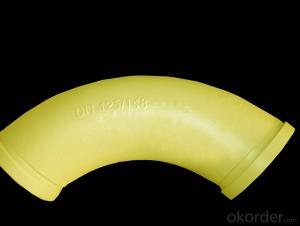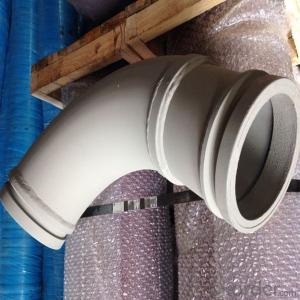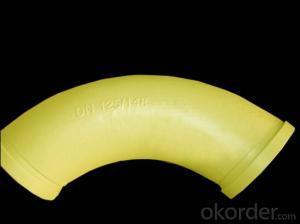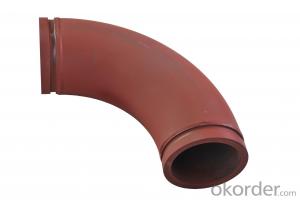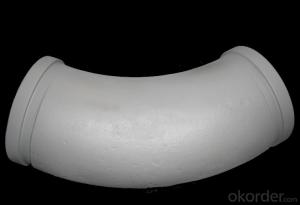Concrete Pump Elbow R275, 90DGR AC Yellow
- Loading Port:
- Tianjin
- Payment Terms:
- TT or LC
- Min Order Qty:
- 10 pc
- Supply Capability:
- 5000 pc/month
OKorder Service Pledge
OKorder Financial Service
You Might Also Like
Product Name: Concrete Pump ELBOW R275, 90DGR AC YELLOW
1. Specification
Dimensions: DN125MM
Radius: 275mm,1000mm
Flange: SK, ZX, F&M
Degree: 30°, 45°, 90°
Material: #20 steel, ST52, Mn 13-4
Thickness: 4.5mm,6mm,7.1mm,7.5mm,10mm,
Working pressure: 180MPa
Notes: total series of Concrete Pump ELBOW R275, 90DGR AC YELLOW for different brand concrete pump(PUTZMEISTER, SCHWING, CIFA, SANY, ZOOMLION, IHI, KYOKUTO Etc) available from us.
2. Application of Concrete Pump Twin Wall ELBOW R275
Concrete Pump ELBOW R275, 90DGR AC YELLOW widely used on concrete pump truck, concrete placing boom, trailer concrete pump etc, for concrete delivery pipe connection.
Our concrete pump bends have been successfully exported to many countries from 1998, Our main markets as below: Middle East, Southeast Asia, America, Brazil, Italy, Russia, South Africa etc
Aiming at the largest concrete pump parts manufacturer, and reliable, professional supplier in China, we can supply concrete pump elbows, delivery pipes, casting or forging couplings, end rubber hoses, rubber pistons, tungsten wear plates, delivery cylinders, and other hydraulic parts, one stop service for your concrete pump parts and accessory business.
3. Package and Delivery of Concrete Pump Twin Wall ELBOW R275
Every 60pcs Concrete Pump ELBOW R275, 90DGR AC YELLOW put in one seaworthy wooden box, and 20 boxes in one 20feet container.
FAQ:
Q1: Why buy Materials & Equipment from OKorder.com?
A1: All products have its ISO certifications, adheres to the highest standards and a commitment to supply chain safety and customer satisfaction.
Q2: How do we guarantee the quality of our products?
A2: We have established an advanced quality management system which conducts strict quality tests at every step, from raw materials to the final product. At the same time, we provide extensive follow-up service assurances as required.
Q3: How soon can we receive the product after purchase?
A3: Within three days of placing an order, we will begin production. The specific shipping date is dependent upon international and government factors, but is typically 10 to 30 workdays.
Q4: If we can produce some Concrete Pump ELBOW R275, 90DGR AC according to customers request?
A4: Yes, we can produce Concrete Pump ELBOW R275, 90DGR AC according to the difference country situations and different concrete pump to make it suitable to the market and customers. We have very professional technical team to make the design.
Q5: How to make a quick resolution for after service?
A5:We have overseas branches all-around of world, IF needed, the seller shall dispatch 2 engineers to the buyer's site for supervision of training. The buyer shall make available of necessary facilities &skilled personnel at site for training.
Images:
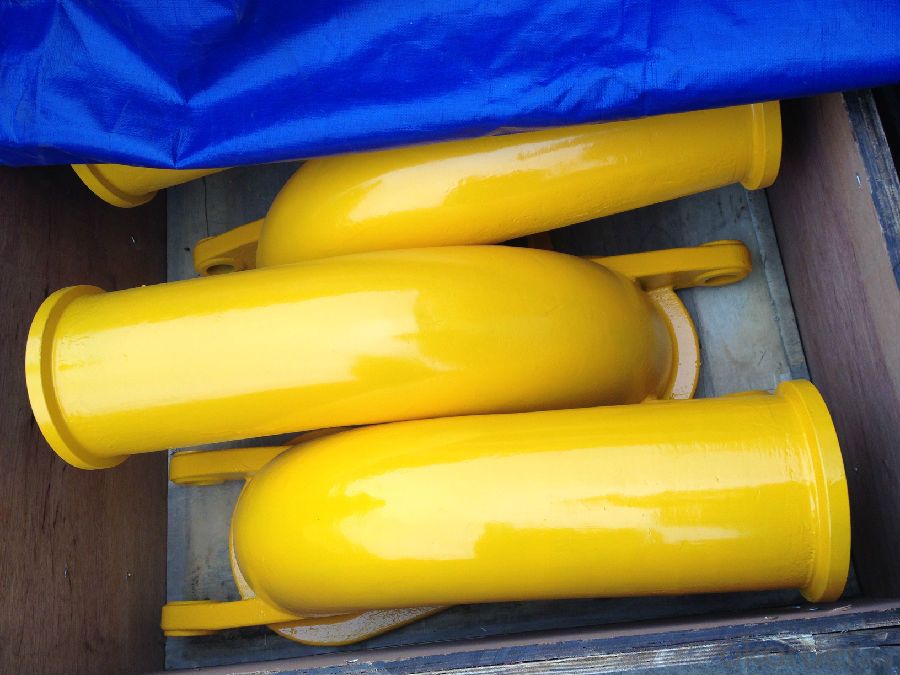
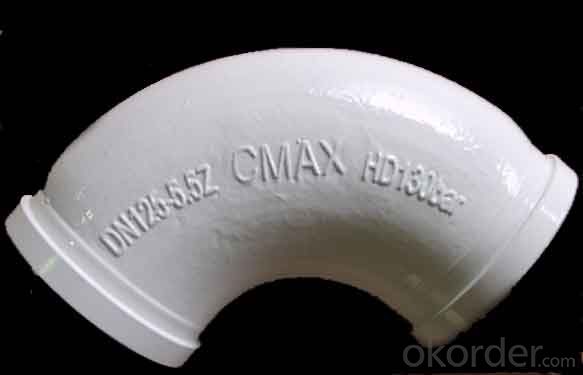
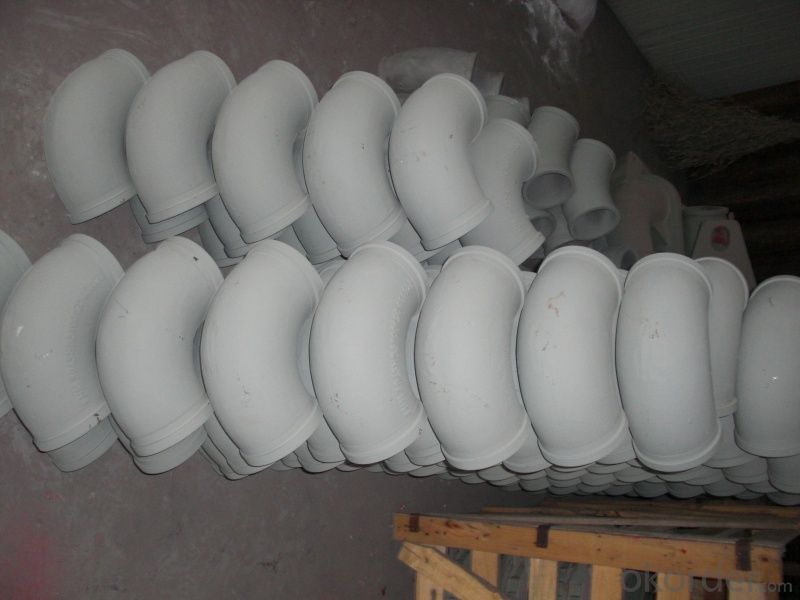
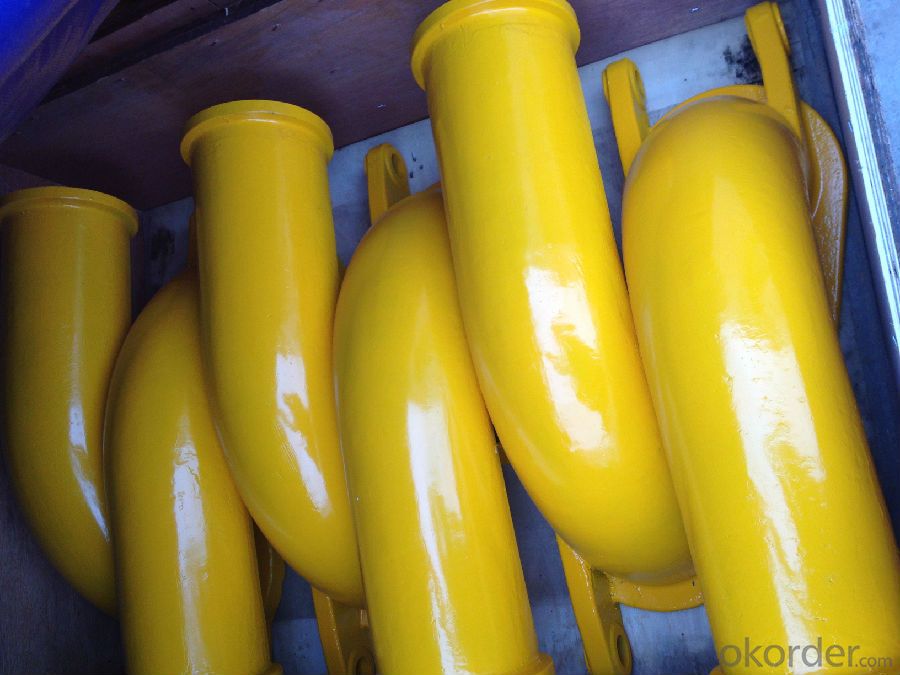
- Q: How often should concrete pump hydraulic filters be inspected and replaced?
- Regular inspection of the hydraulic filters for the concrete pump is recommended, preferably every three months. However, the inspection and replacement frequency may differ based on the concrete pump's specific conditions and usage. In cases where the pump is operated in harsh environments or extensively used, it may be necessary to conduct inspections and replacements more frequently. Close monitoring of the hydraulic filters' condition is crucial, and any signs of clogging, damage, or wear should prompt immediate replacement. Failure to adequately inspect and replace the filters as required can lead to reduced performance and efficiency of the concrete pump, as well as potential harm to the hydraulic system.
- Q: What are the potential risks of using non-standard or modified hydraulic components in concrete pump spare parts?
- The potential risks of using non-standard or modified hydraulic components in concrete pump spare parts include compromised safety and performance. Non-standard or modified components may not meet the necessary specifications or standards required for safe and efficient operation. This can result in increased wear and tear, reduced reliability, and potential failures, leading to accidents, injuries, or damage to the equipment. Additionally, the use of non-standard components may void warranties and make it difficult to find replacement parts in the future. It is crucial to use approved and genuine hydraulic components to ensure the proper functioning and longevity of the concrete pump.
- Q: What are the performance characteristics of concrete pump?
- A long stroke cylinder extends the service life of the cylinder and the piston
- Q: How often should a concrete pump spectacle plate be replaced?
- The frequency of replacing a concrete pump spectacle plate depends on various factors such as usage intensity, maintenance practices, and the condition of the plate. However, as a general guideline, it is recommended to inspect and potentially replace the spectacle plate every 500 to 1000 hours of operation or sooner if signs of wear or damage are observed. Regular inspections and timely replacements help ensure optimal performance and prevent any potential safety risks.
- Q: What is the function of a concrete pump control lever?
- The concrete pump control lever serves the purpose of managing the concrete flow and direction during pumping. It grants the operator the ability to initiate or halt pumping, regulate the pump's speed, and govern the concrete's placement and speed of placement. Additionally, the control lever empowers the operator to transition between various pumping modes, such as vertical or horizontal pumping, and fine-tune the pressure of the pumped concrete. As a whole, the control lever plays a vital role in guaranteeing precise and efficient concrete pumping procedures.
- Q: How can one determine the correct pressure and flow rating for hydraulic components in concrete pump spare parts?
- To determine the correct pressure and flow rating for hydraulic components in concrete pump spare parts, one must consider the specific requirements and specifications of the concrete pump system. This involves understanding the maximum pressure and flow requirements of the pump, as well as considering factors such as the type and size of the concrete being pumped, the distance and height of the pumping operation, and any additional attachments or accessories being used. It is crucial to consult the manufacturer's guidelines and recommendations, as well as seek advice from hydraulic experts, to ensure the hydraulic components are properly selected for optimal performance and efficiency.
- Q: How often should hydraulic pumps be inspected or replaced in a concrete pump?
- Regular inspections of hydraulic pumps in a concrete pump are essential for maintaining their proper functioning and preventing potential problems. The frequency of these inspections depends on various factors, such as the intensity of use, operating conditions, and manufacturer's guidelines. Typically, it is advisable to inspect hydraulic pumps in a concrete pump either every 500 to 1,000 operating hours or at least once a year, whichever comes first. However, if the pump is being used under harsh or demanding circumstances, more frequent inspections might be required. The decision to replace hydraulic pumps should be based on their condition and the recommendations provided by the manufacturer. If the pump displays significant wear and tear, leaks, reduced performance, or any other issues that cannot be resolved through maintenance or repair, it may be necessary to replace the hydraulic pump to ensure the safe and efficient operation of the concrete pump.
- Q: How does a hopper agitator blade ensure smooth concrete flow?
- To guarantee a seamless flow of concrete, a hopper agitator blade is employed to mix and disintegrate any clumps or air pockets in the concrete mixture. Specifically designed to be positioned inside the hopper, the blade rotates and agitates the concrete, ensuring a homogeneous and steady state. While in rotation, the blade disperses any settled aggregates at the hopper's base, preventing blockages or uneven distribution during the pouring procedure. This uninterrupted mixing action guarantees that the concrete remains well-blended and effortlessly pours out of the hopper. Furthermore, the agitator blade aids in breaking up any air bubbles that may have formed within the concrete mixture. These air bubbles can compromise the structural integrity of the concrete and lead to an uneven final appearance. By agitating the concrete, the blade effectively releases trapped air, promoting a consistently dense mixture. In essence, a hopper agitator blade guarantees a seamless flow of concrete by effectively blending the mixture, breaking apart any clumps or air pockets, and fostering a uniform composition. This ensures that the concrete pours smoothly and evenly during the pouring process, resulting in a top-notch end product.
- Q: What is the function of a concrete pump control valve?
- The purpose of a concrete pump control valve is to regulate the concrete flow from the pump to the desired location. By controlling the speed and direction of the concrete, it ensures precise placement. Furthermore, the control valve aids in preventing blockages in the pumping system by enabling the operator to adjust the pressure and flow rate of the concrete. Moreover, it contributes to the safety of the operation as the operator can stop or start the concrete flow as required. In conclusion, the concrete pump control valve is essential for the efficient and effective transfer of concrete from the pump to the desired location.
- Q: Can I get spare parts for concrete pump accessories like remote control systems?
- Yes, spare parts for concrete pump accessories like remote control systems are available. You can find them from various suppliers and manufacturers that specialize in concrete pump accessories.
Send your message to us
Concrete Pump Elbow R275, 90DGR AC Yellow
- Loading Port:
- Tianjin
- Payment Terms:
- TT or LC
- Min Order Qty:
- 10 pc
- Supply Capability:
- 5000 pc/month
OKorder Service Pledge
OKorder Financial Service
Similar products
Hot products
Hot Searches
Related keywords
